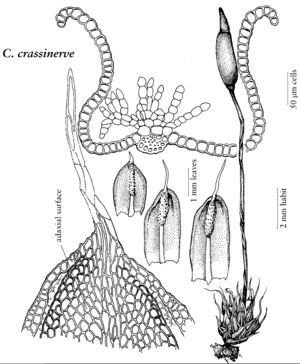Crossidium crassinervium var. crassinervium
Plants 1–5 mm. Leaves lanceolate, lingulate to lingulate-ovate, 0.5–1.3 mm, margins recurved to revolute from near apex to near base, apex obtuse, rounded or emarginate, piliferous; costa excurrent, with an abaxial epidermis, filaments 2–12 cells, cells cylindric, thin-walled, with 2–4 hollow papillae on apical cell, terminal cell cylindric or conic; cells of leaf base 7–58 µm, medial and distal cells 7–22 µm, smooth. Sexual condition dioicous or cladautoicous. Seta 6–13 mm. Capsule urn ovoid-cylindric, 0.9–2.2 mm; operculum 0.6–1 mm; peristome strongly twisted, 400–900 µm. Spores spheric, nearly smooth to conspicuously papillose, 9–15 µm.
Phenology: Capsule mature Dec–Jul.
Habitat: Soil and rocks, on banks and dry washes, under shrubs in desert areas
Elevation: moderate to high elevations (500-1700 m)
Distribution
Ariz., N.Mex., Tex., Utah, Mexico, Europe, Asia (China), Asia (India), n Africa, Atlantic Islands (Canary Islands)
Discussion
Crossidium crassinervium is characterized by the smooth-walled leaf cells and long, thin-walled filaments with cylindric to conic terminal cells. Papillae are present on the apex of the terminal cell and, occasionally, on the distal leaf cells.
Selected References
None.
Lower Taxa
"broad" is not a number."um" is not declared as a valid unit of measurement for this property.
